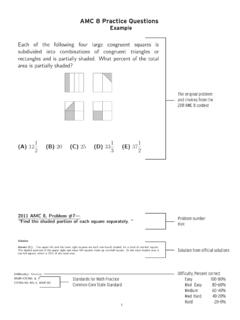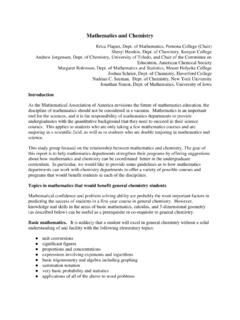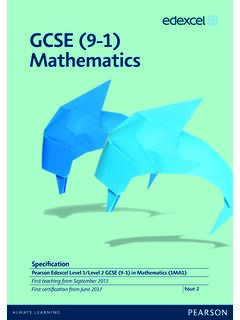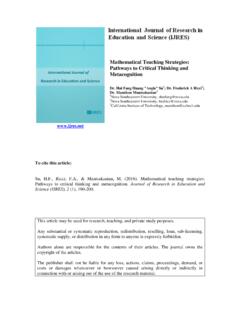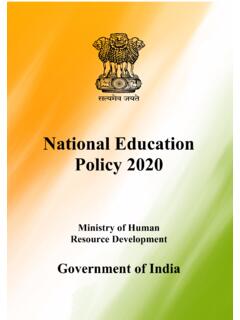Transcription of History of Mathematics - Mathematical Association of America
1 1 History of Mathematics James Tattersall, Providence College (Chair) Janet Beery, University of Redlands Robert E. Bradley, Adelphi University V. Frederick Rickey, United States Military Academy Lawrence Shirley, Towson University Introduction. There are many excellent reasons to study the History of Mathematics . It helps students develop a deeper understanding of the Mathematics they have already studied by seeing how it was developed over time and in various places. It encourages creative and flexible thinking by allowing students to see historical evidence that there are different and perfectly valid ways to view concepts and to carry out computations. Ideally, a History of Mathematics course should be a part of every Mathematics major program. A course taught at the sophomore-level allows Mathematics students to see the great wealth of Mathematics that lies before them and encourages them to continue studying the subject.
2 A one- or two-semester course taught at the senior level can dig deeper into the History of Mathematics , incorporating many ideas from the 19th and 20th centuries that could only be approached with difficulty by less prepared students. Such a senior-level course might be a capstone experience taught in a seminar format. It would be wonderful for students, especially those planning to become middle school or high school Mathematics teachers, to have the opportunity to take advantage of both options. We also encourage History of Mathematics courses taught to entering students interested in Mathematics , perhaps as First Year or Honors Seminars; to general education students at any level; and to junior and senior Mathematics majors and minors. Ideally, Mathematics History would be incorporated seamlessly into all courses in the undergraduate Mathematics curriculum in addition to being addressed in a few courses of the type we have listed.
3 All History of Mathematics courses should incorporate the reading of original sources. Many outstanding mathematicians have acknowledged the benefit they have received from reading the masters. Cognitive Learning Goals. Mathematics History courses are especially effective in helping students improve in the following areas: Integration of ideas usually found in several different Mathematics courses; multiple representations of concepts and multiple ways of understanding them; generalizing from examples to more and more abstract characterizations of ideas; written and oral communication of Mathematical ideas and techniques. The objectives (and outcomes) for math History courses also include clear, critical, creative, and flexible thinking, and an appreciation for the beauty and joy of Mathematics . It is important for students to develop an understanding of Mathematics both as a science and as an art. Mathematics as a deductive science is emphasized in most Mathematics courses; as an art, 2 Mathematics is a creative subject that includes the application of inductive insights and intellectual curiosity to the solution of problems and the formulation of theorems.
4 Also important is the ability to develop a broad concept of the Mathematical sciences as approachable from several points of view, including: problem-solving as a basis for the initial development of many concepts; Mathematics as a human endeavor created by individuals of both genders with their insights and idiosyncrasies; Mathematics as a cultural heritage and the evolving role of Mathematics in cultures throughout the world; the impact of social, economic, and cultural forces on Mathematical study and creativity; interrelations among the various branches of Mathematics , especially their role in the solution of significant problems and in extending the horizons of Mathematics ; and the dynamic nature of Mathematics , including recent developments in pure and applied Mathematics and the increasing role of technology. Diversity of Students and Courses. In recent years, History of Mathematics courses have been taught at a variety of levels to several different student audiences.
5 In addition to courses for Mathematics majors and minors, there are courses for graduate students, courses to satisfy general education requirements, and courses for prospective elementary teachers. Essentially, the audience includes every student at all interested in Mathematics ! The background of the students very much determines the level of the course. It is a challenge to accommodate students with different backgrounds. One approach is to study the History of ideas that are common to the students Mathematical background. This can be done in a manner that challenges, deepens, and develops students understanding of that Mathematics . Extending the students Mathematical knowledge is encouraged provided that attention is paid to both the historical and Mathematical development of the subject. For example, a course composed mainly of general education students might require only high school algebra and geometry and would consist largely of a study of how arithmetic, algebra, and geometry have been understood and developed over time and in various cultures.
6 Such a course also could include an introduction to combinatorial topics new to most of the students, such as counting of permutations and combinations, properties of the Pascal triangle, and/or existence of Euler circuits in networks (graphs), via historical treatment of these topics. Topics for individual (or small group) student projects could be assigned based on individual student backgrounds, depending on the extent to which students are expected to share their projects with the rest of the class. The largest audience for History of Mathematics courses has been Mathematics majors and minors, especially those preparing to teach secondary school. Future secondary Mathematics teachers are served not only by giving them a good sense of how Mathematics developed but also by providing them with ideas about how the History of Mathematics can be incorporated in their classrooms to motivate and instruct their own students. The common Mathematical knowledge of students in such courses may extend only through the Calculus.
7 Students in such courses certainly should study the rich (and related) histories of algebra, geometry, and calculus, but also could be introduced to topics in combinatorics, number theory, and higher algebra and analysis via their histories. Again, topics for individual (or small group) student projects could be 3 assigned based on individual student backgrounds, depending on the extent to which students are expected to share their projects with the rest of the class. Even when Mathematics History is taught as a senior seminar or capstone course, the common Mathematical background of the students may include a relatively small number of Mathematics courses or fields. As in the courses addressed above, most of the students common experiences in this course should include Mathematics common to all of them, with Mathematics new to any of them introduced as new Mathematics via its History . Students could and should pursue their own Mathematical specialties and interests via individual projects.
8 In addition to gaining a deeper understanding of Mathematics at the appropriate level, all Mathematics History students will obtain an appreciation of the role Mathematics has played for centuries in western culture and to recognize achievements in other cultures. We hope Mathematics History courses will help to counteract the fear and hatred of Mathematics that many general education or liberal arts students express. We hope that students who love Mathematics will feel even more closely connected to culture and society after studying the central role played by Mathematics in both. We also hope studying Mathematics History will help these students better communicate Mathematical ideas to those whose Mathematical understanding is not as great as theirs. Prerequisites. The requirements for three disparate groups are the following: 1. Mathematics majors and minors, especially those preparing to teach secondary school Mathematics : These prerequisites vary, but often include only Calculus I, II, and/or III; sometimes Linear Algebra and/or an introduction to proofs course.
9 2. Masters degree students preparing to teach or currently teaching secondary school Mathematics : same as above, but perhaps not as recently. 3. General education students: high school algebra and geometry. Methodology. In most states prospective secondary teachers are required, in order to obtain a teaching certificate, to take a course in the History of Mathematics . This positive development took place in the past two decades and has put a burden on departments to find willing and qualified teachers. The NCTM standards have encouraged college faculty to model the student-centered interactive instruction that future teachers are expected to use. Thus the lecture method of teaching has been discouraged in favor of in-class activities, group work, discussion, and student presentations. Perhaps the biggest change in the teaching method used in History of Mathematics courses is the use of original sources. To read an original piece of Mathematics , even in English translation, gives the student a much better understanding of how its author thought about, understood, and developed Mathematics and of what it means to do History of Mathematics .
10 Usually, instructors who wish to have students grapple with original sources use reading from sourcebooks from the list below and/or material found on the web. They often have students work through passages from original sources in small group discussion outside of class or, more commonly, in small group or whole group discussion in class, and they sometimes have students explain these passages in writing. 4 Although Mathematics History instructors assign their share of rather traditional Mathematics homework exercises or problems, many of them provided in the math History texts they use, student presentations and research papers are more common in Mathematics History courses than in other math courses. These presentations and papers vary in length (from course to course or within a single course), but typically focus on individual mathematicians or on individual results or topics in Mathematics History . Those who use William Dunham s Journey Through Genius: The Great Theorems of Mathematics (see list of texts below) as a text for their courses often assign a great theorem paper written in the form of an additional chapter for the text as a major paper or final project for their courses.


